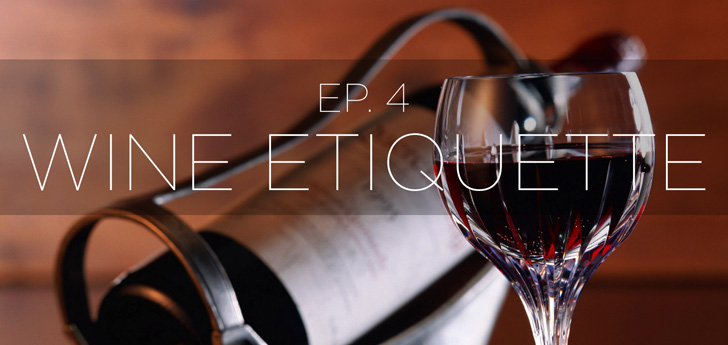
Dining Etiquette: how to order wine like a boss
Pretention is an attribute often associated with wine or wine knowledge. At times this might scare people off, but the truth is, most of us will be drinking wine for the rest of our lives, so it’s due time we learn how to approach it in a way that we find accessible. Whether you frequent the wine section of your local dépanneur looking for the highest percentage for the cheapest price, or are an accredited sommelier, we can all still learn a thing or two about wine etiquette, also known as, how to order wine like a boss.
Lets begin with the wine masters of the world. I think I speak for all of us “commoners” when I say, drop the pretention. No one cares about that 2003 Pinot Noir you once tried that was ‘a good, crisp, non-malolactic wine but slightly oaky for your taste,’ you sound like a dillhole. You make others feel uncomfortable and uniformed about their own wine knowledge. To be honest, people want to hear about that wine, just as much as they want to hear you tell the story again, about that one time that you were at the same party as Drake… ten years ago. Wine is supposed to be fun, and enjoyable, so relax. I truly believe that wine, like food is best served WITHOUT the side of pretension.
For those of you that aren’t too comfortable with wine, there are a few things to keep in mind when ordering at a restaurant. First, have faith in your server and the restaurant staff. Don’t be afraid to ask the server for recommendations, it’s what they’re there for. Describe a couple of the qualities that you do enjoy in wine, such as ‘I like sweet, fruity, red wines’ or tell them one grape varietal you do enjoy, such as ‘I usually just buy the 1.5 liter bottle of Torro Loco from the dépanneur but I think I also like Cab Sauv.’ Have faith that the server will bring you something you will enjoy, they’re significantly more well versed in the wine selection than you are, and don’t waste their time asking them to bring you taster after taster. Second, ask for suggested pairings and understand the importance of them. Mixing the wrong wine and food can be like eating sushi with a milkshake. Finally don’t be afraid to venture off the extremely beaten path that is Pinot Grigio. There are a variety of varietals and just because everyone’s ordering it, doesn’t mean its good.
Learning the basics of wine characteristics isn’t difficult, here are a few wine 101 definitions to keep in mind:
Body: The weight of the wine in your mouth, or how thick and rich it feels.
Dry: The amount of sweetness and residual sugars that are in the wine.
Acid: The amount of acidity in the wine, which often leads to a crispness in taste or scratches the back of your throat when you swallow.
Tannins: Naturally occur in grape skins or stems and create dustiness, which you feel in your cheeks.
Understanding wine etiquette is important, even though it may seem pointless to some it’s worth is well valued. Having even simply an entry level knowledge will allow you understand that when you order a bottle of wine at a restaurant and server pours you a small amount, its to check for flaws in the wine, not to determine if you like the taste or not. Comparable to if you’re ordering something else off a menu, you can’t send back a burger because you forgot you were a vegetarian, but you definitely can if there’s a bug in it. If the wine is corked and has gone bad, it will smell like wet cardboard or mildew, this is when you can send the wine back. Other flaws include oxidization and ‘cooking’ of the wine. Oxidization occurs when the wine has been open for too long (this wont happen if you’re ordering a bottle but might if you order a glass) and will leave the wine tasting overly acidic. ‘Cooking’ occurs when the wine has been exposed to too much heat or hasn’t been properly stored in a cool place. This is perhaps the most important part of wine etiquette.
Other formalities include, but are not limited to:
Holding the glass by the stem: This is to prevent the wine from being heated by the warmth of your hand. (And also to keep the glass free of fingerprints.)
Saluting or Cheersing: A simple clink of the glass is polite when opening a new bottle of wine, and make sure to make eye contact, and remember to drink after you cheers.
Corkage Etiquette: Once you have ordered a bottle the server will present it to you. Confirm that it is the right wine that you ordered and allow the server the pour you a taster.
Wine isn’t so scary once you learn the fundamentals, and if you plan on indulging in the future, remembering the basic concepts and customs will help you look like you know your wines and impress the people around you, and you might even enjoy a drink or two while your at it.
Pretention is an attribute often associated with wine or wine knowledge. At times this might scare people off, but the truth is, most of us will be drinking wine for the rest of our lives, so it’s due time we learn how to approach it in a way that we find accessible. Whether you frequent the wine section of your local dépanneur looking for the highest percentage for the cheapest price, or are an accredited sommelier, we can all still learn a thing or two about wine etiquette, also known as, how to order wine like a boss.
Lets begin with the wine masters of the world. I think I speak for all of us “commoners” when I say, drop the pretention. No one cares about that 2003 Pinot Noir you once tried that was ‘a good, crisp, non-malolactic wine but slightly oaky for your taste,’ you sound like a dillhole. You make others feel uncomfortable and uniformed about their own wine knowledge. To be honest, people want to hear about that wine, just as much as they want to hear you tell the story again, about that one time that you were at the same party as Drake… ten years ago. Wine is supposed to be fun, and enjoyable, so relax. I truly believe that wine, like food is best served WITHOUT the side of pretension.
For those of you that aren’t too comfortable with wine, there are a few things to keep in mind when ordering at a restaurant. First, have faith in your server and the restaurant staff. Don’t be afraid to ask the server for recommendations, it’s what they’re there for. Describe a couple of the qualities that you do enjoy in wine, such as ‘I like sweet, fruity, red wines’ or tell them one grape varietal you do enjoy, such as ‘I usually just buy the 1.5 liter bottle of Torro Loco from the dépanneur but I think I also like Cab Sauv.’ Have faith that the server will bring you something you will enjoy, they’re significantly more well versed in the wine selection than you are, and don’t waste their time asking them to bring you taster after taster. Second, ask for suggested pairings and understand the importance of them. Mixing the wrong wine and food can be like eating sushi with a milkshake. Finally don’t be afraid to venture off the extremely beaten path that is Pinot Grigio. There are a variety of varietals and just because everyone’s ordering it, doesn’t mean its good.
Learning the basics of wine characteristics isn’t difficult, here are a few wine 101 definitions to keep in mind:
Body: The weight of the wine in your mouth, or how thick and rich it feels.
Dry: The amount of sweetness and residual sugars that are in the wine.
Acid: The amount of acidity in the wine, which often leads to a crispness in taste or scratches the back of your throat when you swallow.
Tannins: Naturally occur in grape skins or stems and create dustiness, which you feel in your cheeks.
Understanding wine etiquette is important, even though it may seem pointless to some it’s worth is well valued. Having even simply an entry level knowledge will allow you understand that when you order a bottle of wine at a restaurant and server pours you a small amount, its to check for flaws in the wine, not to determine if you like the taste or not. Comparable to if you’re ordering something else off a menu, you can’t send back a burger because you forgot you were a vegetarian, but you definitely can if there’s a bug in it. If the wine is corked and has gone bad, it will smell like wet cardboard or mildew, this is when you can send the wine back. Other flaws include oxidization and ‘cooking’ of the wine. Oxidization occurs when the wine has been open for too long (this wont happen if you’re ordering a bottle but might if you order a glass) and will leave the wine tasting overly acidic. ‘Cooking’ occurs when the wine has been exposed to too much heat or hasn’t been properly stored in a cool place. This is perhaps the most important part of wine etiquette.
Other formalities include, but are not limited to:
Holding the glass by the stem: This is to prevent the wine from being heated by the warmth of your hand. (And also to keep the glass free of fingerprints.)
Saluting or Cheersing: A simple clink of the glass is polite when opening a new bottle of wine, and make sure to make eye contact, and remember to drink after you cheers.
Corkage Etiquette: Once you have ordered a bottle the server will present it to you. Confirm that it is the right wine that you ordered and allow the server the pour you a taster.
Wine isn’t so scary once you learn the fundamentals, and if you plan on indulging in the future, remembering the basic concepts and customs will help you look like you know your wines and impress the people around you, and you might even enjoy a drink or two while your at it.





